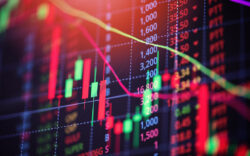Editor’s note: Spoiler alert – AI is coming for businesses and jobs. Yet it’s not all doom and gloom. At Southbank Investment Research, we want to help you prepare and potentially take advantage of the ever-changing and ever-evolving world of AI. In fact, my colleague over at Southbank Growth Advantage, Sam Volkering, has all the details on how you can get on the right side of the AI trend, right here.
In today’s issue:
- Entire industries are undergoing a sea change
- AI could boost the global economy by $200 trillion…
- Investors need to position themselves accordingly
As the world moves away from fossil fuels to one that’s increasingly powered by renewables, one industry is becoming critical to the energy transition: mining.
But miners are facing quite the challenge.6 kg of cobalt
Mining, of course, is a very carbon-intensive industry. It accounts for between 4% and 7% of global greenhouse gas emissions. That means that miners, like every other industry, are feeling the pressure to decarbonise their activities.
On top of that, miners haven been tasked with supplying the critical raw materials needed to drive the energy transition, which is also going to be a considerable challenge.
Just consider what goes into an electric vehicle (EV) battery.
While amounts will vary depending on type, a typical EV battery holds around:
…11.3 kg of lithium…
…13.6 kg of cobalt…
…27 kg of nickel…
…50 kg of graphite…
…and 40 kg of copper, along with other stuff like steel, aluminium and other components.
But of course, miners need to extract plenty of ore to produce these amounts of lithium, cobalt, nickel, graphite and copper… around 41,000 kg per battery.
Furthermore, to access that amount of ore, they need to dig out plenty of dirt – on average, around 230,000 kg. Remember, this is just to make one EV battery.
Challenges for miners don’t end there.
Miners need to decarbonise their activities and extract an impressive amount of raw materials from the ground at a time when discovery rates and ore quality are declining.
Extracting materials from lower grade ore means using more energy, higher costs and waste along with greater environmental impact.
Therefore, it’s clear that miners of battery metals are facing twin challenges:
- They need to scale up production quickly to meet expected demand growth; and
- They need to decarbonise their activities to reduce emissions and address climate risk.
No wonder, then, that, right now, the mining industry is crying out for ways to make exploration more efficient and precise.
This is where AI comes in.
You see, while mining companies may usually have lots of data, they don’t actually use that much of it when it comes to exploration.
For one, they may not have the time or resources to organise all their data. Data may contain errors, data gaps or may even be in different formats.
What’s more, the fact that commodities usually have cycles can also disrupt the business causing companies to lose employees and knowhow.
In fact, when it comes to conventional mineral exploration, companies will use between 20% to 40% of their data at most, which can also be subject to human bias.
But increasingly, companies are working out ways to apply AI and machine-learning algorithms to this data to first find the location of mineral deposits and then “predict” their size, grade and likely depth.
The idea is that targeted exploration will improve discovery rates, reduce drilling, timeframes and costs. And of course, to help reduce the industry’s environmental footprint.
Something similar is taking place in the oil and gas industry, too, which is also using AI to optimise operations, cut costs and improve safety.
And it’s easy to see why…
After all, a 1% platform improvement boosts revenue by $300 million.
Accounting giant PwC predicts AI will boost Middle East oil revenue by $320 billion by 2030.
But that’s not all…
The biggest cost in oil and gas is dry wells. (Something my colleague Sam, and our in-house AI expert, discusses in more detail over here.)
It typically costs between $5 million and $9 million to drill an oil well. If there’s no pay-dirt at the end, that’s a heavy loss.
Just like in the mining industry, AI can analyse seismic data to predict oil fields with astonishing accuracy.
So it’s no surprise that BP is already using AI to identify oil fields and improve drilling operations.
Shell has developed an AI system to predict equipment failures, reduce downtime, and improve safety.
Saudi Aramco, the world’s largest oil company, has even developed an autonomous AI-powered drilling rig.
That’s why we’re about to see a $5 billion AI investment flow into the oil and gas industry by 2030.
Other established industries are changing beyond recognition too.
In fact, AI-controlled machines will soon plant, nurture and harvest everything we eat. Because by 2050, we will need to produce 60% more food just to feed the global population.
That giant leap in food production is almost impossible with current farming techniques because we don’t have enough land or water.
This is where AI can come to our rescue.
CropX, an AI soil monitoring system, reduces water usage by 57%, cuts fertiliser use by 15%, and increases yield by 70%.
But that’s not all…
Pests destroy around 40% of food in the field. Costing farmers at least $70 billion a year.
New AI systems are solving this $70 billion problem without chemical pesticides.
That’s why the AI farming market is expected to boom from $3 billion today… to $12 billion by 2026.
That’s a $9 billion investment surge – in just the next 18 months.
In fact, in total, AI is about to boost the global economy by $200 trillion.
That’s 85 times bigger than crypto… four times the size of the S&P 500… and almost double the entire global economy.
This would make it easily the biggest financial opportunity in the world today.
There’s a simple way to position yourself to potentially see huge returns in the coming months.
Click here to see all the details and proof for yourself.
Until next time,

James Allen
Contributing Editor, Fortune & Freedom



